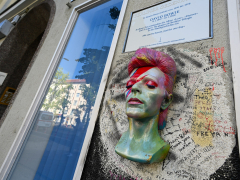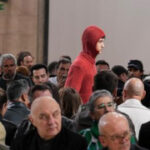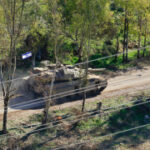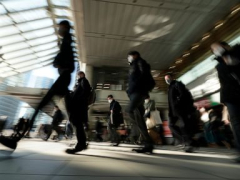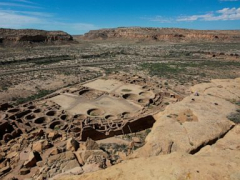Berlin, Germany – When David Bowie’s Glass Spider Tour arrived in West Berlin on June 6, 1987, the city was the world’s de facto capital of geopolitical turmoil, cleft in two physically and politically by 168km (104 miles) of machine-gun-guarded concrete wall.
The stage on which Bowie was to perform lay to the west of the division line on the derelict lawn of West Berlin’s Platz der Republik, a grassy square in front of the imperious Reichstag building. The building had once been the seat of the German government (and is again today) but in the late 1980s had stood largely unused since World War II due to its proximity to the Berlin Wall looming directly behind it.
The tour had come to participate in the Concert for Berlin, an event held as part of the city’s 750th-anniversary celebrations, and when the performance venue was erected, its West Berliner organisers made sure that several speakers were pointing directly at the Wall.
It was a cool evening when Bowie and company took to the stage beneath a 15-meter (50-foot), illuminated spider before an audience of some 80,000 fans. At the same time, listeners from the east gathered as close as they dared, their numbers accumulating steadily.
Attendees to the west got their money’s worth, as Bowie rocked through a lengthy 24-song set followed by three encores. The tracks were largely drawn from his latest run of albums – Scary Monsters, Let’s Dance and Never Let Me Down – but a few harkened back to those he’d recorded a decade earlier while living in the city, most notably his anti-Wall anthem, “Heroes”.
By all accounts the performance was well-received by those watching from the Reichstag. Bowie himself later expressed that it was an emotional experience.
For those listening to the east, however, the music may have been welcome, but the atmosphere was oppressive as members of the Volkspolizei – the People’s Police, a civilian wing of the much-feared Stasi secret police – spent the duration of the concert hassling and intimidating those who had congregated to hear it.
The following evening as the crowd swelled precipitously for a second day of music, violence erupted when East German authorities cracked down on eastern listeners – a repressive act that only inflamed opposition and ultimately contributed to the Wall’s collapse.

A tale of two cities
At the time, Berlin sat at the crux of the Cold War. In the wake of World War II, the victorious powers had chopped Germany into four regions, each occupied and administered by one of the United States, the USSR, the United Kingdom and France. But with Berlin situated deep inside the Soviet zone, it was agreed that the capital, too, would be divided along similar lines.
Then in 1961, following years of rising tension, the Soviets boxed in the western Allied section of the city with a heavily fortified and guarded barrier – the infamous Berlin Wall – which divided families and severed economic and social ties.
“It’s hard for any of us to really imagine,” says Berlin Wall historian Hope M Harrison, professor of history and international affairs at George Washington University. “This was a world metropolis like New York, London, Paris, Rome – and suddenly to have it divided in two!” Families were separated, employees cut off from their jobs, students from school. “It had a huge, devastating impact on the people of Berlin.
“For Berlin, it was a gash through the city,” Harrison explains. “For the world, it symbolised two things: the Cold War – here it is in concrete – but also both the brutality and simultaneously the weakness of the Communist regime.” That the powers that lay to the east felt it necessary to wall its people in was “a kind of admission of defeat”, she added.
Life on both sides of the barrier became increasingly grim. Those to the east experienced pervasive censorship and a rapid diminishing of material standards due to the food and supply shortages that plagued the Soviet Union. Those in West Berlin settled into their besieged enclave, where greater cultural freedom allowed for wide-ranging artistic experimentation, but the sense that it was all teetering on the brink persisted.
“West Berlin very much became a countercultural place,” says Harrison, gravitating artists, punks, anarchists, and East Germans looking to escape compulsory military service. “It was living on the edge, so it attracted people who were happy to live on the edge, some of them with the Berlin Wall literally in their back yard or across the street.”

The fall of Ziggy Stardust
“That’s why I went to Berlin,” said Bowie, who moved to West Berlin in 1976 at the age of 31. “I wanted to have another kind of friction … people living under the impression that everything might collapse very quickly.”
Drowning in the recent superstardom brought on by The Rise and Fall of Ziggy Stardust and accompanied by flat-mate and then-floundering former Stooges frontman Iggy Pop, Bowie ostensibly went to Berlin to escape the raging cocaine addiction that had prompted his previous handful of albums – particularly Station to Station, the production of which Bowie later reported he had little to no recollection.
Raised in Bromley, not far from London, he had gone to the US in 1974 but, after two years of maximalist rockstar debauchery across New York City and Los Angeles, the singer was desperate for change. The Thin White Duke (as he was monikered during his Station years) was in a transitional mode and Iron Curtain-era Berlin seemed an appropriate environment for this modulation.
“I knew I had to get to an environment that was totally different from Los Angeles,” he explained towards the end of 1977. “The most arduous city that I could think of, and it was West Berlin. It’s a very good, therapeutic city for an artist.”
By the time Bowie arrived in Berlin, its Cold War culture conflict was in full swing and music played no small part in the struggle. That same year, famed German folk singer Wolf Biermann had his East Berlin citizenship revoked while he was away performing in West Berlin, barring him from returning home: His crime – writing a song critical of the Stasi that was sung among its prisoners.
Western music was largely banned in the east, though East Germans still received radio and television transmissions from the other side of the Wall, as well as smuggled cassette tapes and records cut into medical x-ray films known as “ribs”, “jazz on bones”, or “bone music”.

The Berlin Trilogy
“It’s a very tight life there, surrounded by a wall with machineguns,” Bowie said of life in West Berlin. “The longer you live there the more it comes in, and the Wall by the end feels as though it’s right around the apartment or house you’re staying in.”
In fact, Bowie could see the Wall from Hansa Studio, where he finished his 11th and 12th albums, Low and Heroes, and produced Iggy’s second solo release, Lust for Life. Hansa is still there today, just around the corner from sections of the Wall displayed in the square of Potsdamer Platz (which Bowie mentioned in “Where Are We Now?” 30 years later, a song largely about the day the divide finally fell – November 9, 1989).
These days, it is flanked by a fashionable shopping centre and the luxurious Ritz-Carlton hotel rather than the armed guard towers that enforced the division of the city for some three decades. It was beneath one of those towers that Bowie spied the inspiration for Heroes’ titular track. Producer Tony Visconti and singer Antonia Maass would steal away to kiss in the shadow of the Wall during recording sessions; Bowie used the image of that as a symbol of the power of love over oppression.
“It’s about what it means to be a hero and stand up,” said Harrison. “I think this song is very relevant right now. Standing up against what you feel is wrong and shameful.”
Over the ensuing decades, the song Heroes went on to become the most recognised anthem from what was dubbed Bowie’s Berlin Trilogy, but what is most distinct about Heroes the album and its forerunner Low are their least-known tracks: The synth-driven, largely lyricless compositions that comprised the second side of both records.
“I needed to discover for myself a new form of musical language before I continued writing,” Bowie explained. “Low and Heroes aren’t so much situations, but a process of discovery. Searching for a new artistic language so that I can go further.”
Going further meant leaving something behind, and it was in Berlin that he killed off the characters behind whom he’d long hidden – Major Tom, Ziggy Stardust, Aladdin Sane, Halloween Jack, the Thin White Duke – and embraced an identity he had heretofore obscured: Himself.
“I never wanted to appear as myself on stage ever,” he said in 1979, shortly after leaving Berlin for the Isolar II World Tour – said to be his healthiest tour in years due to the noticeable reduction in cocaine use – “until recently.”

Changes
When you compare the interviews Bowie gave before and after Berlin, it’s plain to see that he had undergone a fundamental change during the roughly 18 months he lived there. Before, there was a dolled-up rock star trying to bluff away nerves. After, he seemed remarkably mature, calm and clear-eyed.
Escaping the throttle of cocaine probably didn’t hurt, but it was something more than

